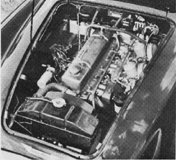The following article is as it appeared, with supporting graphics, in the December 1958 edition of
SPORTS CARS ILLUSTRATED. The Austin Healey was one of nine cars reviewed for this christmas bonus issue.

![]()
IF THERE is any truth to the old
saying that racing improves the breed it is to be seen in the
Austin-Healey. This ubiquitous automobile has probably been subjected to
more racing in its short span of years than any other marque with the
possible exception of MG and Porsche.
There is good reason for this. Designer Donald Healey's whole
lifetime has been devoted to going fast on four wheels and it shows up
in the products of his design. In brief, properly set up, the
Austin-Healey is one of the most eminently raceable production
automobiles extant and the men of Warwick have provided a lengthy list
of options to abet the practice. When these options are properly
applied, the comparatively mild and docile touring sports car takes on
an entirely different character, turning from a street machine that can
be raced to a racing car that can be driven on the street.
We have had the good fortune to have lived in close harmony with
both versions during the past summer and it has been an enlightening
experience indeed. The difference is not in sheer speed nor vastly
increased acceleration but in the way the natural speed and power of the
car can be applied. put it this way: the absolutely plain stock car we
tested last month turned the standing quarter mile in 18.8 seconds,
reaching a hair over 75 mph at the end. It was carrying full street
equipment. The race-prepared Austin-Healey turned the quarter in 17
seconds flat. hitting a little over 80 (speedo subject to error due to
gear changes) as it crossed the finish line. Most of its extra speed and
quicker time came from its ability to haul off the mark without wasting
time in wheel hop or spin.
 The main difference between the show-room Healey (top) and the prepared one is something that cannot be photographed-speed and "feel."Although lean appears identical, speed was not. |
It was in lap times around Lime Rock Park that the difference showed. The show-room machine went around the circuit in one minute, 20 seconds plus a varying fraction after a few laps of practice. The prepared car did the same distance-a mile and a half-in 1.15 flat on one pushed lap and a consistent l.16 without undue hurrying time after time. Yet both cars reached approximately the same speed on the straight The prepared car would hit about 115 before being shut off and braked for the 180-degree turn at the end of the straightaway - The showroom car was within a couple of miles an hour of this and, due to lower (higher numerical) rear end gearing of 4.1 to 1 as opposed to 3.6 to 1, hit the speed quicker. Why the difference? Most of it was in handling and braking where the shut off point for the stocker was the hundred foot marker, the prepared car could be floor-boarded right down to the fifty foot mark berore backing off and braking. The turn entering the straight is a fast right hand bend just at the foot of a steep hill and it requires a good deal of practice before the right line and the optimum cornering speed can be found for any given car. The competition car could motor through this bend at a speed somewhere between 80 and 85 mph. The stock machine began to be distinctly uncomfortable at anything over 70, a pretty respectable speed in that particular set of circumstances for any production sports car and suicidal in a Detroiter. The same situation applied on the other bends and corners. While the stock Healey was quicker coming out of slow corners, the competition car maintained a higher rate of speed all the way through and would come out with as much as a ten mile an hour edge on the normal car. Now you can begin to see whence comes that five-second difference in lap times. The prepared car could go deeper into a corner and go through it faster. In a ten-lap race the difference is almost a full lap.
Let's compare the cars bearing in mind that
every item on the prepared machine is a catalogued Healey part. They may
not be the easiest things in the world to get but they can be ordered.
In some cases substitutions could probably be manufactured by the
enterprising tuner. All of these options were available as of this past
year, but due to a clerical error all but one missed the SCCA red-book's
deadline.
 Contour-topped
pistons, different cam, balancing, port matching and polishing do
nothing to alter the outward appearance of the engine. Contour-topped
pistons, different cam, balancing, port matching and polishing do
nothing to alter the outward appearance of the engine. |
Let's start with the engine. Only two modifications were made here-- special contour-topped pistons and the optional camshaft (which made the book). Using the thick gasket instead of the more normal thin shim gasket, the pistons do not raise the compression ratio much over stock (about 9.5 :1 would be a fair estimate). What they will do is create a better combustion pattern, especially in the upper rev ranges. They're also a bit lighter and in this case are operated by a .040 inch undersized nitrided crankshaft. Any ordinary stock Healey will twist quite a bit past the rev limit of 5200 rpm but in no case should a Healey Six be turned much beyond 5500. The optional cam supplied by Healey does not up the rpm factor but steepens the power curve and seems to stretch the peak out for a wider range near the top end of the scale. On this particular engine there were other detail operations that did nothing to increase its performance but rather enhanced its reliability. All freeze plugs were safety blocked and all access plate bolts were safety wired. An oil cooler (a standard Healey part) was also installed though later disconnected at the behest of the SCCA panjandrums. These plus a carefully balanced selective assembly and matched porting completed the engine room work.
The chassis mods were equally simple and equally effective. springs and shocks are the factory option competition units and the shocks are filled with heavy duty fluid. Dunlop disc brakes with quickchange pads are mounted on all four corners. So are the sixty spoke optional wheels used to keep the increased braking from wringing the hubs loose on hard stops. They were fitted with Dunlop R-3 racing tires. The gearbox, unadorned by overdrive, was fitted with a centermounted extension and lever, giving a shorter throw and bringing the lever closer to hand. The final bit of equipment is the installation of the Healey 30-gallon fuel tank and a reserve fuel pump. This tank is unnecessary for most American events and has actually proved a hindrance for short sprint races since an inordinate weight of gasoline must be carried to be sure that it would not "run dry" on hard corners.
Sixty spoke alloy wheels and Dunlop R-3 tires allow power to be used... quickly and safely |
The result of these chassis mods is that
the car is board-flat in the corners and absolutely controllable and
predictable right up to the ragged edge of adhesion. This in turn
inspires tremendous confidence which, in turn, produces a heavier right
foot. Of all the cars tested for this section, this was the most
startling in results gained from any given operation. From a mild
mannered though exhilarating street machine, the car was turned into a
real racing automobile.
There will be no clerical mistakes this year and Austin-Healey will be the car to watch.
JPC
©2004 eric wilkins design & illustration
